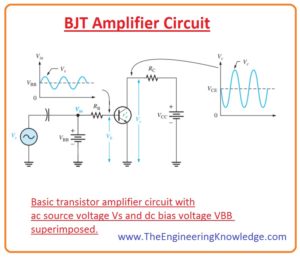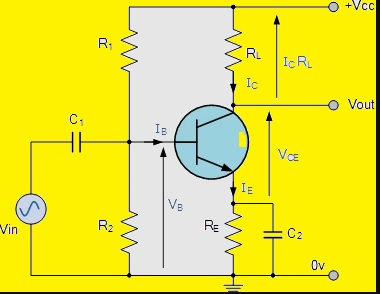 Hello dear students, I hope you all are doing great. In today’s tutorial, we will have a look at BJT as an Amplifier. A transistor is an electronic component that has three terminals. Terminals are base-emitter, collector, and base. It is used in different electronic projects and circuits for switching and amplification processes.
Hello dear students, I hope you all are doing great. In today’s tutorial, we will have a look at BJT as an Amplifier. A transistor is an electronic component that has three terminals. Terminals are base-emitter, collector, and base. It is used in different electronic projects and circuits for switching and amplification processes.
Amplification is a process through which a weak input signal is amplified to a larger level. In today’s post, we will have a detailed look at the amplifier circuit using BJT. We will make a complete amplifier circuit and discuss all its parameters. So let’s get started with the BJT as Amplifier.
BJT as Amplifier
DC and AC Quantities
- Before understanding of bjt as amplifier circuit, we must know about the designations used in the amplifier circuit for voltage current and resistor since in this amplifier circuitry ac and dc parameters are simultaneously used.
- Capital alphabets in an italic font will be used for both ac and dc current (I) and voltages (V).
- This principle is applicable to the peak, rms (root mean square), average and peak-to-peak ac parameters.
- The values used in circuitry for ac current and voltages are root mean squares until are mentioned for other types,
- Some parameters will use lowercase (i) and (v) for ac current and voltage, this lowercase text will use for only instantaneous quantities.
- DC values used in amplifier circuitry will have uppercase non-italic subscripts.
- For instance, IB, IC, IE are dc current values of the transistor and VBE, VCB, and VCE are a value of dc voltage between any two terminals of the transistor.
- The value like VB, VC, and VE that has single sub-scripted voltage are the voltage between the terminal of the transistor and the ground.
- Ac and other variable parameters will have an italic subscript.
- For instance, Ib, Ic and Ie are the current values of the transistor.
- While Vbe, Vcb, and Vce are the ac voltage values between two terminals of the transistor.
- The voltage values that have single subscript are ac voltage between the transistor terminal and ground such as Vb, Vc, and Ve.
- The internal resistance of the transistor will be denoted by the lowercase having subscript.
- For instance, internal ac emitter resistance is denoted as r’e
- Circuit resistances exterior to the transistor itself use the italic capital R with a subscript that recognizes the resistance as dc or ac like the current and voltage.
- For instance, RE is an exterior dc emitter resistor and Re is an exterior ac emitter resistance.
- So friends I hope you understand all the parameters and terms used in the amplifier circuit.
- All these parameters will help to understand the circuit and equation used for amplifier circuitry.
BJT Voltage Amplification
- As we know that Ic=βIb that mean current is amplified. In transistors, the value of the base current is less ac compared to the emitter and collector current so the emitter and collector currents are almost equal.
- By keeping in mind this discussion let’s have a look at the below given circuitry.
- You can see that ac voltage Vs is carried on the DC-biased voltage VBB.
- The dc biased voltage VCC is provided to the collector with the resistance R
- The ac input voltage generates ac base current due to that high ac collector current is generated.
- Due to ac collector current ac voltage is generated about the resistance RC, therefore creating an amplified, but inverted, generation of the ac input voltage in the active region of a transistor is shown in the above figure.
- The base-emitter junction which is in forward-biased condition provides less resistance to the ac signal.
- This interior ac emitter resistance r’e is shown in the figure and in series with the RB.
- The value of base ac voltage is given here.
Vb = Ier’e
- The ac collector voltage Vc, is equal to the voltage loss across the resistance RC.
Vc = IcRC
As Ic=Ie
- So collector voltage will be written as.
Vc =IeRC
- Vb can be supposed as the ac input voltage for the transistor. Here Vb =Vs- IbRB.
- Vc can be taken as the ac output voltage of the transistor.
- As the ratio between the output to input is known as voltage gain.
- So the ratio between Vc to Vb is ac voltage gain and denoted as Av.
Av=Vc/Vb
- If we put IeRC in place of Vc and Ier’e for Vb than we have.
Av= IeRC/ Ier’e
- By simplifying this equation we have.
Av= RC/ r’e
- From this equation, you can see that the bjt used in circuitry gives amplification in the shape of voltage gain that is dependent on the values of RC and r’e.
- As RC is always significantly higher, the output voltage for this arrangement is larger than the input voltage.
Working of bjt as an amplifier
- here we have explained bjt as an amplifier.
- In bjt as an amplifier, the AC signal that is connected at the emitter pin gets amplified and generates the collector voltage. In this bjt amplifier, there is no phase shift between the input and output signal. The main characteristics of BJT as an amplifier are
- Its current gain is unity
- It produces a high value of voltage gain
- its input resistance is low
- It has a high output resistance
Bjt as an amplifier formula
- In BJT amplifier configuration value of the emitter current is higher than the collector current
- IE = IB + IC
- So the current gain of the amplifier is less than the unity because the collector current is less than the emitter curent minus the base current
- IE = IB + IC
- is formal of BJT amplifier in common emitter configuration
Bjt as an amplifier example
- Common Base (CB) Amplifier
- Common Collector (CC) Amplifier
- Common Emitter (CE) Amplifier
Bjt as an amplifier diagram
bjt as an amplifier working
In BJT amplifier is AC signal is given to the emitter pin that will be simplified and amplified voltage is received at the collector. Input and output voltage have zero phase shift between input and output signal
FAQs:
How does BJT work as an amplifier?
- BJT works as an amplifier if it is biased in linear regions. The transistor used as a switch if biased in saturation and cut-off region. It helps current to flow to other components of circuits
- How does a transistor work as an amplifier?
- The transistor comes with three layers of semiconductor material and has three pins and each layer and pin has a current. While working as an amplifier it converts small signal input current to larger output current
- Why BJT is used as an amplifier in active regions?
- In the active region, the transistor works as a linear component since the Q point has a value that is working as linear and does not have any harmonics in the output.
- How do you amplify current with BJT?
- In BJT amplifier configuration transistor is used to flow current from the power source to the transistor output pin. Output pin current will increase in proportion to the current at the input pin
- How a BJT can be used as a switch and as an amplifier?
- it is used as an amplifier and switch by producing a small current at one terminal and getting high current passes between two other terminals.
- Does a BJT amplify current or voltage?
- For common collector configuration, it amplifies voltage not current
- How does a BJT amplify voltage?
- A small value of AC voltage at the base produces a small base current that is amplified by a transistor to provide a larger AC collector current
- What type of amplifier is a BJT?
- Small signal amplifiers that are bipolar junction transistors (BJT) work as linear amplifiers.
- What is the condition for a transistor to act as an amplifier?
- The transistor must be accurately biased to work as an amplifier. The DC-biased voltage must be given to the emitter-base junction. This connection arrangement is forward biased condition
- How do you wire a transistor as an amplifier?
- A common emitter configuration of a transistor is used to work as an amplifier
- How do transistors amplify current?
- The small current moves from the power supply to the base. Current at base on the transistor. Current is then amplified and moves from the emitter of the transistor to the collector. This amplified current used on the led
So, friends, it is a complete post about BJT as an amplifier. If you have any questions about the BJT amplifier ask in comments. Thanks for reading.







I really enjoyed your post. Three thumbs up